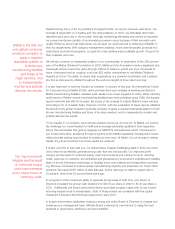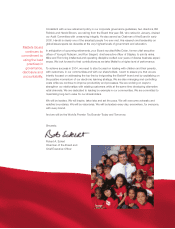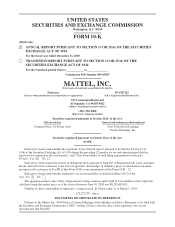Mattel 2003 Annual Report Download - page 16
Download and view the complete annual report
Please find page 16 of the 2003 Mattel annual report below. You can navigate through the pages in the report by either clicking on the pages listed below, or by using the keyword search tool below to find specific information within the annual report.Product Design and Development
Through its product design and development group, Mattel regularly refreshes, redesigns and extends
existing toy product lines and develops innovative new toy product lines for all segments. Mattel believes its
success is dependent on its ability to continue this activity. See Item 7 “Management’s Discussion and Analysis
of Financial Condition and Results of Operations—Factors That May Affect Future Results.” Product design and
development are principally conducted by a group of professional designers and engineers employed by Mattel.
Independent toy designers and developers bring concepts and products to Mattel and are generally paid a
royalty on the net selling price of products licensed to Mattel. These independent toy designers may also create
different products for other toy companies.
For new product introductions, Mattel’s strategy is to begin production on a limited basis until a product’s
initial success has been proven in the marketplace. The production schedule is then modified to meet anticipated
demand. Mattel further limits its risk by generally having independent contractors manufacture new product lines
in order to minimize capital expenditures associated with new product introductions. This strategy has reduced
inventory risk and has limited the potential loss associated with new product introductions.
Mattel devotes substantial resources to product design and development. During 2003, 2002 and 2001,
Mattel spent approximately $167 million, $159 million and $176 million, respectively, in connection with the
design and development of products, exclusive of royalty payments. See Item 8 “Financial Statements and
Supplementary Data—Note 13 to the Consolidated Financial Statements.”
Advertising, Marketing and Sales
Mattel supports its product lines with extensive advertising and consumer promotions. Advertising
continues at varying levels throughout the year and peaks during the traditional holiday season. Advertising
includes television and radio commercials and magazine and newspaper advertisements. Promotions include in-
store displays, sweepstakes, merchandising materials and major events focusing on products and tie-ins with
various consumer products companies. Mattel has two retail stores, American Girl Place®in Chicago and New
York City, each of which features children’s products from the American Girl Brands segment. Mattel also has
several other smaller retail outlets at its corporate headquarters and distribution centers as a service to its
employees and as an outlet for excess product. American Girl Brands has a retail outlet in Oshkosh, WI that
serves as an outlet for excess product.
During 2003, 2002 and 2001, Mattel spent approximately $636 million (12.8% of net sales), $553 million
(11.3% of net sales) and $544 million (11.6% of net sales), respectively, on worldwide advertising and
promotion.
Mattel’s products are sold throughout the world. Products within the Domestic segment are sold directly to
large retailers, including discount and free-standing toy stores, chain stores, department stores, other retail outlets
and, to a limited extent, wholesalers. Products within the International segment are sold directly to retailers and
wholesalers in Canada and most European, Asian and Latin American countries, and through agents and
distributors in those countries where Mattel has no direct presence.
During 2003, Mattel’s three largest customers (Wal-Mart at $1.0 billion, Toys “R” Us at $0.8 billion and
Target at $0.4 billion) accounted for approximately 47% of consolidated net sales in the aggregate. Within the
International segment, there is also a concentration of sales to certain large customers that do not operate in the
US. The customers and the degree of concentration vary depending upon the region or nation. See Item 7
“Management’s Discussion and Analysis of Financial Condition and Results of Operations—Factors That May
Affect Future Results” and Item 8 “Financial Statements and Supplementary Data—Note 8 to the Consolidated
Financial Statements.”
7
























